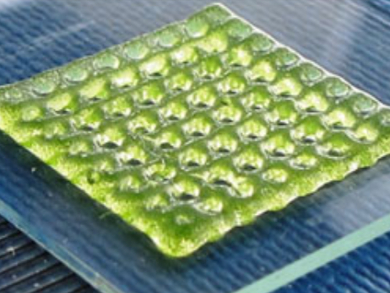Microalgae are of great interest for various applications such as exploitation of solar energy, conversion of CO2, production of metabolites. Since they are sensitive to a range of contaminants, they also can be used as biosensors. As microalgae are very small, the harvesting of cells for such applications from suspensions includes various centrifugation and filtration steps.
Anja Lode, Technical University Dresden, Germany, and colleagues used 3D plotting to bypass these work-intensive procedures. In 3D plotting, highly viscous materials are dispensed to build up to a 3D structure in a layer-by-layer fashion. Here, algae are first mixed with a hydrogel paste and then plotted in a defined 3D structure. The algae survive the plotting process and show cell growth and photosynthetic activity within in the hydrogel scaffold.
The team also showed that the plotting technique can be used for co-cultivation of human cells and algae. For this, multichannel-plotting is used. Each channel contains either human cells or algae mixed with the hydrogel material. In the resulting structure, human cells are in close vicinity to the algae but not in direct contact with them. Their growth benefits from the direct oxygen supply by the algae.
- Green bioprinting: Fabrication of photosynthetic algae-laden hydrogel scaffolds for biotechnological and medical applications,
A. Lode, F. Krujatz, S. Brüggemeier, M. Quade, K. Schütz, S. Knaack, J. Weber, T. Bley, M. Gelinsky,
Eng. Life Sci. 2015.
DOI: 10.1002/elsc.201400205




